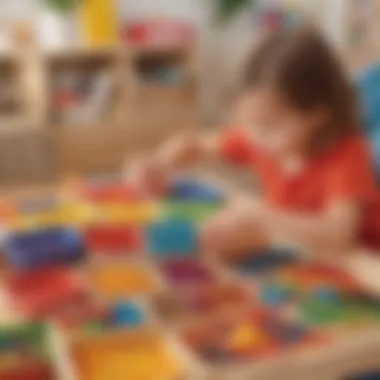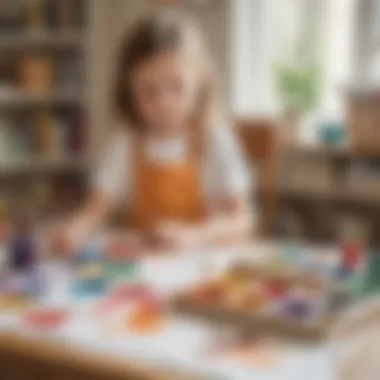Engaging Educational Activities for 4 Year Olds: A Complete Guide


Fun Activities Ideas
As parents and caregivers, engaging 4-year-olds in various activities is crucial for their development. Let's explore some exciting options that combine fun with learning:
- Indoor Activities: Create a cozy reading nook with plush pillows and interactive books to ignite their imagination.
- Outdoor Adventures: Take them on nature walks to observe flora and fauna up close, fostering their curiosity about the world.
- Arts and Crafts: Set up a mini art station with non-toxic paints and recyclable materials to unleash their creativity.
- Science Experiments: Conduct simple experiments like mixing colors or making a volcano to introduce them to basic scientific concepts.
- Cooking and Baking: Allow them to assist in simple kitchen tasks like mixing batter or shaping cookies to enhance their motor skills.
Educational Games
Games are a fun way to instill educational concepts in young minds. Here are some stimulating options to consider:
- Math and Logic Games: Introduce puzzles and counting games to boost their numerical and critical thinking skills.
- Language and Vocabulary Games: Play word-building games or rhyming exercises to enhance their language proficiency.
- STEM Activities: Engage them in building blocks or simple coding games to foster an early interest in science, technology, engineering, and math.
- History and Geography Puzzles: Explore maps or historical figures with interactive puzzles to expand their knowledge of the world.
- Interactive Learning Apps: Utilize age-appropriate educational apps to make learning engaging and interactive.
Seasonal and Holiday Activities
Celebrating special occasions adds a touch of excitement to a child's life. Here's how you can make each season memorable:
- Valentine's Day Crafts: Engage in heart-themed crafts like handmade cards or DIY gifts to celebrate the day of love.
- Halloween Costume Ideas: Encourage them to design their costumes or participate in themed dress-ups for Halloween.
- Thanksgiving Cooking Projects: Involve them in preparing simple recipes like decorating cookies or making themed snacks for Thanksgiving.
- Christmas Decorations: Decorate the house together, making DIY ornaments or creating holiday-themed crafts.
- New Year's Resolutions for Kids: Reflect on the past year and encourage goal-setting practices to start the new year on a positive note.
Parenting Tips and Resources
Guiding young children requires patience and strategy. Implement these tips for a fruitful parenting journey:
- How to Encourage Creativity: Provide open-ended toys and materials to inspire imaginative play and creativity.
- Setting up a Playful Learning Environment: Designate specific areas for play and learning to create a structured yet fun atmosphere.
- Balancing Screen Time and Playtime: Regulate screen time exposure and promote outdoor activities to ensure a well-rounded development.
- Building Strong Family Bonds: Engage in group activities like family game nights or outings to strengthen familial connections.
- Motivating Kids to Stay Active: Encourage physical activities like dancing or sports to instill healthy habits from a young age.
Fun Facts and Trivia
Learning can also be exciting through intriguing facts and trivia. Delve into these interesting topics with your little ones:
- Animal Kingdom Discoveries: Explore fascinating facts about different animals, their habitats, and behaviors.
- Famous Inventions Stories: Uncover the stories behind famous inventions and inventors that shaped our world.
- Historical Events for Kids: Simplify historical events into engaging narratives to spark an interest in the past.
- Mythical Creatures Explorations: Encourage imaginative play by introducing mythical creatures and their legends.
- Space Adventures and Discoveries: Dive into the wonders of outer space, planets, and astronauts' adventures for an out-of-this-world experience.
Introduction
In this comprehensive guide on educational activities for 4-year-olds, we embark on a journey to explore the myriad of ways in which young children can engage in enriching experiences to aid in their development and learning. By delving into various stimulating and educational activities, this article aims to provide parents, teachers, and caregivers with valuable insights into how these activities can play a fundamental role in nurturing young minds.


Understanding the Importance of Educational Activities for 4-Year-Olds
Educational activities for 4-year-olds are not merely about keeping them occupied; they serve as crucial building blocks for their cognitive, social, and emotional development. At this tender age, children are like sponges, absorbing knowledge and experiences at a rapid pace. By engaging them in educational activities tailored to their age group, we create a foundation for a lifelong love of learning. These activities stimulate curiosity, creativity, and critical thinking skills, laying the groundwork for academic success and overall well-being. Moreover, educational activities promote essential skills like problem-solving, communication, and resilience, shaping children into well-rounded individuals ready to navigate the complexities of the future.
Overview of Developmental Milestones at Age
At the age of 4, children reach significant developmental milestones that underscore the importance of tailored educational activities. Physically, they display improved coordination and dexterity, allowing them to engage in more intricate tasks and hands-on activities. Cognitively, their minds are eager for exploration and experimentation, making it an ideal time to introduce them to foundational concepts in STEM, language, and numeracy. Socially, 4-year-olds begin to blossom into budding social beings, learning to navigate friendships, emotions, and teamwork. Emotionally, they exhibit increased independence and self-awareness, making it vital to provide them with enriching experiences that foster confidence and emotional resilience. By aligning educational activities with these developmental milestones, we ensure that children receive the support and stimulus they need to thrive in every aspect of their growth journey.
Sensory Play Activities
Sensory play activities play a crucial role in the developmental journey of 4-year-olds, offering them a hands-on and engaging way to explore their surroundings and enhance their cognitive abilities. In this section of the article, we will delve into the significance of sensory play activities, shedding light on the specific elements, benefits, and considerations that make them a valuable asset in a child's educational experience.
Exploring Texture and Sensory Input
Kinetic Sand Exploration
Kinetic Sand Exploration introduces children to a unique tactile experience, allowing them to feel and mold the sand while engaging their senses. The key characteristic of Kinetic Sand is its ability to mimic the properties of wet sand but without the mess, making it a popular choice for parents and educators alike. Its non-toxic nature ensures safe play, and the kinetic properties enhance sensory development by providing a soothing and therapeutic sensation. While Kinetic Sand offers a sensory-rich play experience, some considerations include potential clean-up after playtime and ensuring young children do not ingest the material.
Water Bead Sensory Bins
Water Bead Sensory Bins immerse children in a sensory delight, as they explore the texture and sensory input of these colorful water beads. The key characteristic of Water Bead Sensory Bins is their ability to expand in water, creating a tactile and visually stimulating activity. This hands-on approach captivates children's attention, fostering sensory exploration and fine motor skills development. The unique feature of Water Bead Sensory Bins lies in their versatility, allowing for different play scenarios and sensory experiences. However, supervision is recommended to prevent the ingestion of water beads and to ensure a mess-free sensory play environment.
Engaging in Mess-Free Sensory Activities
Sensory Bags with Paint
Sensory Bags with Paint offer a mess-free alternative to traditional finger painting, allowing children to explore colors and textures without the need for cleanup. The key characteristic of Sensory Bags with Paint is the sensory engagement it provides through visual and tactile stimuli, promoting artistic expression and creativity. This activity is a beneficial choice for this article as it combines sensory play with artistic development, offering a versatile and engaging experience for young learners. The unique feature of Sensory Bags with Paint is the containment of paint within a sealed bag, minimizing mess while maximizing sensory exploration. However, careful monitoring is necessary to prevent accidental tears and leaks in the sensory bags, ensuring a safe and enjoyable sensory play session.
STEM-Based Learning
STEM-based learning plays a crucial role in shaping the educational activities for 4-year-olds in this comprehensive guide. STEM, which stands for Science, Technology, Engineering, and Mathematics, introduces children to fundamental concepts that lay the foundation for critical thinking, problem-solving, and creativity. By integrating STEM activities into early childhood education, young learners cultivate a curiosity for the world around them while honing essential skills for future academic success. Parents, teachers, and caregivers can harness the power of STEM to offer stimulating experiences that enhance cognitive development and spark a love for learning. The hands-on nature of STEM-based learning encourages experimentation, exploration, and discovery, fostering a deep understanding of complex subjects in a fun and engaging manner. Through STEM activities, children not only acquire knowledge but also develop key skills such as resilience, collaboration, and adaptability, preparing them for a rapidly evolving world.
Introduction to STEM Concepts


Introducing young children to STEM concepts lays a strong foundation for cultivating a lifelong interest in science, technology, engineering, and mathematics. At age 4, children are naturally curious and eager to explore the world around them. By incorporating hands-on activities that promote STEM principles, educators can tap into this innate curiosity to ignite a passion for learning. STEM introduces children to real-world applications of academic concepts, making learning tangible and relevant. From observing the natural world to conducting simple experiments, young learners begin to develop a deeper appreciation for the wonders of science and technology. By engaging with STEM concepts early on, children build a solid framework of knowledge that will serve them well as they progress through their academic journey.
Hands-On Science Experiments
Hands-on science experiments offer young children the opportunity to engage with scientific concepts in a practical and interactive way, fostering a love for exploration and discovery. Fizzing Ice Cubes, for example, introduce children to chemical reactions in a captivating and hands-on manner. By combining simple household ingredients, children can observe the fizzing reaction as the ice cubes melt, sparking curiosity and wonder. This experiment not only teaches scientific principles but also promotes critical thinking and problem-solving skills. Rain Cloud in a Jar is another captivating experiment that brings the water cycle to life. By creating a miniature cloud inside a jar, children learn about condensation and evaporation in a visually engaging way. These experiments not only enhance scientific literacy but also nurture a sense of wonder and curiosity about the natural world.
Mathematics Made Fun
Mathematics is often perceived as a challenging subject, but by making it fun and engaging, children can develop a positive attitude towards numbers and problem-solving. Counting with LEGO bridges the gap between play and learning, allowing children to practice counting skills in a hands-on and interactive way. By using colorful LEGO bricks, children can visualize abstract concepts and engage with mathematical ideas in a tangible way. This activity not only reinforces numeracy skills but also promotes creativity and spatial awareness. By incorporating mathematics into play-based activities, children develop a strong foundation in mathematical concepts while having fun and exploring their creativity.
Creative Arts and Crafts
Creative arts and crafts play a pivotal role in the educational activities for 4-year-olds as they offer a platform for self-expression and creativity. Engaging in artistic endeavors from a young age helps children develop fine motor skills, hand-eye coordination, and cognitive abilities. Through activities like painting, drawing, and crafting, children can explore various mediums, colors, and techniques, fostering their imagination and tactile senses. Creative arts and crafts activities not only enhance aesthetic awareness but also encourage problem-solving and decision-making skills in young learners.
Exploring Artistic Creativity
Finger Painting
Finger painting, a staple in creative arts and crafts for young children, allows them to express themselves freely using their hands as brushes. This sensory-rich activity stimulates tactile exploration and hand strength while promoting sensory integration. The tactile sensation of the paint on their fingers can be both exciting and soothing for children, enhancing their sensory development. Finger painting is renowned for its messiness, which fosters a sense of spontaneity and experimentation in young artists, encouraging them to explore and create without constraints.
Pasta Art
Incorporating pasta into art projects introduces children to a versatile and tactile medium that fuels their creativity. Pasta art offers a textural element to artworks, allowing children to experiment with patterns, shapes, and structures. By gluing different types and sizes of pasta onto paper, children can create unique masterpieces, developing their fine motor skills and spatial awareness. The process of manipulating and arranging pasta pieces enhances children's hand-eye coordination and concentration, promoting attention to detail in their artistic expressions.
DIY Projects for Little Hands
Paper Plate Masks
Paper plate masks serve as an engaging DIY project that combines creativity with imaginative play for young children. Crafting masks from paper plates encourages children to explore different facial features, colors, and shapes, fostering their understanding of emotions and expressions. This activity promotes role-playing and storytelling, allowing children to embody various characters and enhance their social and emotional development. Paper plate masks provide a hands-on experience that boosts children's cognitive skills and encourages them to think creatively while having fun.
Outdoor Adventures
In this comprehensive guide on Educational Activities for 4-Year-Olds, Outdoor Adventures play a pivotal role in providing young children with invaluable experiences and development opportunities. Engaging in outdoor activities allows 4-year-olds to explore the natural world, enhancing their sensory experiences and fostering a connection with nature. It promotes physical health and well-being by encouraging movement and exercise in an open, natural environment, which supports overall development.


Outdoor Adventures offer a dynamic learning environment that stimulates curiosity and creativity in children. By immersing themselves in nature exploration activities, youngsters develop a deep appreciation for the environment and cultivate important skills such as observation, problem-solving, and critical thinking. Furthermore, outdoor adventures provide a platform for sensory exploration, allowing children to engage with various textures, sounds, and sights that are not typically experienced indoors.
For parents, teachers, and caregivers, incorporating Outdoor Adventures into a child’s routine offers numerous benefits beyond physical health. It encourages independent exploration and builds confidence as children navigate outdoor spaces and interact with the natural world. Additionally, outdoor activities promote socialization and collaboration among peers, fostering important social skills such as communication, teamwork, and empathy.
Nature Exploration
Leaf Rubbings
Within the realm of Nature Exploration, Leaf Rubbings stand out as a captivating activity that merges art and nature for 4-year-olds. This hands-on experience involves placing a leaf under a piece of paper and then rubbing a crayon or pencil over it to create a detailed impression of the leaf's texture and shape. Leaf Rubbings not only allow children to engage with nature creatively but also encourage sensory stimulation and fine motor skill development.
The key characteristic of Leaf Rubbings is their ability to provide children with a tangible connection to the natural world. This activity enables youngsters to observe and appreciate the intricate details of leaves, fostering curiosity and a deeper understanding of plant life. Moreover, Leaf Rubbings offer a sensory-rich experience as children feel the textures of different leaves and explore variations in size, shape, and patterns.
One notable advantage of Leaf Rubbings in this article is their versatility and accessibility. This activity requires minimal materials, making it easy for parents and educators to facilitate in various settings. Additionally, Leaf Rubbings can be adapted to suit different skill levels, allowing children to explore creativity at their own pace and comfort level.
Gardening for Beginners
Gardening for Beginners introduces 4-year-olds to the joys of cultivating plants and nurturing growth in a hands-on learning experience. This activity provides children with a practical understanding of plant life cycles, the importance of care and responsibility, and the satisfaction of witnessing plants thrive under their care.
Engaging in gardening fosters a sense of connection to nature and instills valuable life skills such as patience, perseverance, and environmental awareness. It offers children a sensory-rich experience as they touch soil, plant seeds, and witness the transformation of seeds into sprouts and eventually plants. Gardening also encourages a sense of ownership and pride as children observe their efforts leading to visible results.
For children, gardening serves as an immersive outdoor activity that promotes physical activity, exploration, and curiosity. It allows them to engage with the natural world in a hands-on manner, fostering a sense of wonder and appreciation for the environment. Gardening for Beginners helps 4-year-olds develop an understanding of basic botany concepts and the interconnectedness of living organisms, laying a foundation for future interest in plant biology and environmental stewardship.
Music and Movement
Music and movement play a vital role in early childhood development, engaging children's senses and promoting physical activity. In this article, the emphasis is on incorporating rhythmic fun activities to enhance coordination, rhythm recognition, and motor skills in 4-year-olds. Through music and movement, children can express themselves creatively while improving balance and spatial awareness. These activities aim to stimulate both the mind and body of young learners, fostering holistic growth through interactive experiences.
Rhythmic Fun
Dance Party
Dance Party is a dynamic activity that encourages children to move to the beat of music, promoting cardiovascular health and coordination. The key characteristic of Dance Party lies in its ability to energize and excite children, allowing them to express themselves through creative movement. This activity is a popular choice for this article as it combines physical exercise with musical expression, offering a holistic approach to learning and development. The unique feature of Dance Party is its capacity to enhance rhythmic patterns and cultivate a love for music and movement at an early age. While Dance Party provides numerous benefits such as improving physical fitness and boosting mood, it may pose challenges in managing group dynamics and ensuring safety during energetic movements.
Musical Chairs
Musical Chairs is a classic game that encourages children to engage in playful competition while enhancing listening skills and spatial awareness. The key characteristic of Musical Chairs is its ability to promote social interaction and quick decision-making in a playful setting. This activity is a popular choice for this article as it fosters excitement and friendly competition among children, encouraging teamwork and sportsmanship. The unique feature of Musical Chairs is its simplicity yet effectiveness in teaching children the concept of taking turns and adapting to changing situations. While Musical Chairs offers advantages such as promoting social skills and enhancing cognitive abilities, it may present challenges in ensuring inclusivity and fairness during gameplay.
Interactive Music Sessions
DIY Instruments
DIY Instruments involve creating musical tools from everyday items, fostering creativity and resourcefulness in children. The key characteristic of DIY Instruments is their versatility and affordability, allowing children to explore sound and music in a hands-on manner. This activity is a beneficial choice for this article as it encourages innovation and experimentation while introducing children to basic musical concepts. The unique feature of DIY Instruments is the opportunity for children to personalize their creations, promoting ownership and engagement in musical activities. While DIY Instruments offer advantages such as encouraging imagination and problem-solving skills, they may present challenges in terms of durability and sound quality. Overall, interactive music sessions with DIY Instruments offer a blend of education and entertainment, inspiring young learners to explore the world of music through creative expression.



